Haghpat Monastery
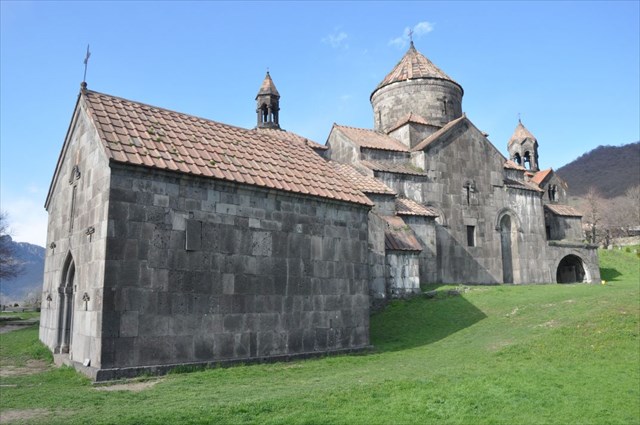
Retracing steps across the Debed river, take the main road N, passing the Sanahin bridge, built in 1192. The bridge is elegantly decorated with stone cats. About one km after crossing back to the E side of the Debed on leaving Alaverdi Town, a cluster of large modern buildings, the transport terminal (?), marks the turn-off right to Haghpat and Tsaghkashat (149 v., till 1935 Khachidur). Take the left fork which winds up to Haghpat (Հաղբատ, 448 v.), with one of Armenia’s most beautiful monasteries perched atop the rim of the gorge. This fortified monastery was founded, like Sanahin Monastery, by Queen Khosrovanush around 976. It has a S. Nshan church finished in 991 by Smbat Bagratuni and his brother Gurgen, and served as the religious headquarters of the Kyurikians. The gavit was built in 1185, with the following inscription on the N facade: “In the year 634/AD 1185, I Mariam, daughter of King Kyurike, built with great hope this house of prayer over our tombs -- those of my paternal aunt Rousoudan, my mother Tamara, and myself, Mariam, under the superior Ter Barsegh, archbishop, who finished the construction. You who enter through its door and prostrate yourself before the cross, in your prayers remember us and our royal ancestors, who rest at the door of the holy cathedral, in Jesus Christ.” A smaller S. Grigor church was built in 1025 and rebuilt in 1211. There is a huge, self-standing gavit of the Abbot Hamazasp built in 1257, a “grand and marvelous bell tower” of 1245, and a library built in 1262. There is a large dining hall incorporated in the defensive wall, and several other picturesque chapels and mausoleums. Haghpat was major literary center, and maintained rich feudal lands until the monastery properties were confiscated by the Russian Empire in the 19th c.
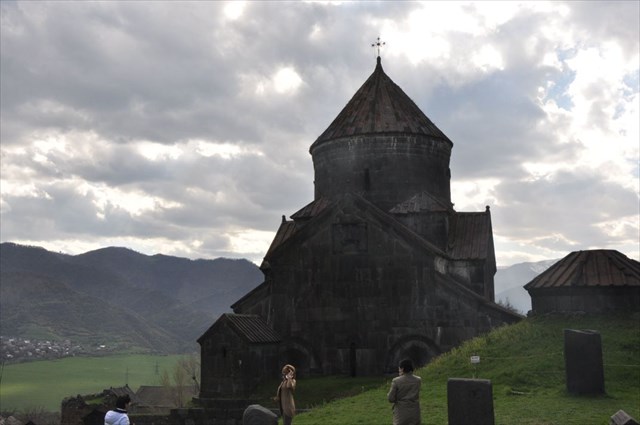
The architectural complexes of Sanahin and Haghpat are among the outstanding works of medieval Armenian architecture. In their artistic merits they transcend the limits of national culture.
The monasteries are situated in the north of Armenia, in the Tumanian district. Sanahin is now within the limits of Alaverdi city, and Haghpat is to the north-east of it, in the village of the same name. Standing on a high plateau, amidst low structures, they rise sharp against the background of steep forest-grown slopes of Bazum ridge. The ensembles are complemented by small churches built near them.
The exact date of the foundation of Sanahin and Haghpat is unknown. Documentary evidence and monuments of material culture suggest that these structures date back to the middle of the 10th century. The formation of Tashir-Dzoraget kingdom of the Kyurikids in 979 and the great attention paid to Sanahin and Haghpat by various rulers of Armenia and their vassals favored the construction of many religious and civil structures there. In these monasteries, especially in Sanahin, humanitarian sciences and medicine were studied, scientific treatises written and paintings, most miniatures, created.
Built in the monasteries over three centuries were more than 20 various churches and chapels, four annexes, sepulchers, bell-towers, the building of the Academy, book depositories, refectories, galleries, bridges and other monumental structures, to say nothing of numerous dwelling and service premises.
The main monastery buildings are grouped around their chief temples, forming integral architectural organisms. They are asymmetrical relative to their main axes, which lends them picturesqueness. Compactness and harmonious balancing of the complexes are achieved owing to the fact that each subsequent architect proceeded from the state of the ensemble that already existed and coordinated the shape and layout of his own buildings with it.

What Sanahin and Haghpat complexes have in common is not only the compositional features of various structures. The architectural details and decoration of the monuments, which belong to the same epoch, have much in common and are even exactly alike in some cases, which gives us ground to presume that they were created by craftsmen of the same school.
Most of the religious structures are of the cross-winged dome type and have annexes in four corners, or of the cupola hall type. The structures of the fist type are: in Haghpat, St. Grigory church (1005), which lost its dome during the reconstruction in 1211; in Sanahin. St. Hakob church (the 9th century), St. Astvatsatsin church, built some time between 928 and 944. and Amenaprkich church, completed in 966.
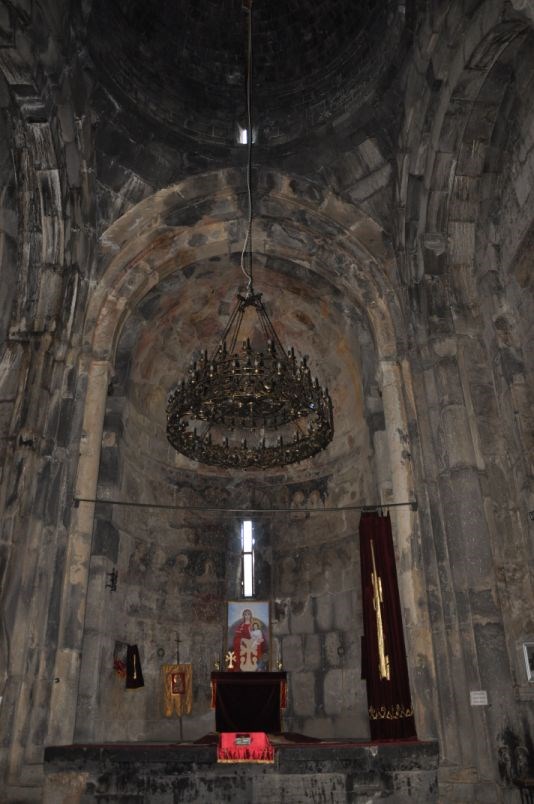
Standing out among these churches is Amenaprkich built by Khosrovanuish, the wife of Ashot III Bagratuni. This majestic structure with a transversally-oriented interior crowned with a huge dome in the center, has two-tier annexes. The altar apse and the dome drum were decorated with graceful arcatures which went well with the patchily ornamented window and door platbands accentuating the smooth spaces of the facades. The severe and majestic eastern facade is crowned in its gable with a monumental sculptural group of Kings Kyurike and Smbat. Chronologically, this is the first high-relief representation of human figures with a model of a church, which gives it great importance in Armenian art.
The most important of the cupola-hall type buildings is Nshana church in Haghpat, founded by Khosrovanuish in 976 and completed in 991. It is distinguished by its compactness and harmoniously balanced shapes crowned with a tremendous dome. In the interior, the fancy shape of the high cupola abutments, protruding to the center, is smoothly combined with high arches, resting on them and changing over from the semicircular to the pointed shape. The decoration, particularly ornamental carving, is very modest. A sculptural group of Smbat and Kyurike kings with a model of the temple in hands, a replica of that in Sanahin, is in a higher relief, which brings it closer to a three-dimensional sculpture fitted into a wall niche. This method of using sculpture also occurs in later monuments, for instance in the main temple of Harich monastery (1201).
The interiors of Astvatsatsin and Amenaprkich churches in Sanahin and Nshana in Haghpat, just as those of some other churches, were decorated with frescoes which are almost totally lost by now. The altar apse of Nshana church was decorated with frescoes twice, the last time in the second half of the 13th century. Probably the whole of the interior was covered with frescoes, of which only the representation of Paron Khurlu-bugi on the southern wall is relatively well preserved. In its stylistic features — color tone soft multi-layer treatment of the picture, etc. the technique of portraiture and of the murals of Kobayr and Haghtala monasteries is close to that of Georgian mural painting which was highly developed in the 12th century.
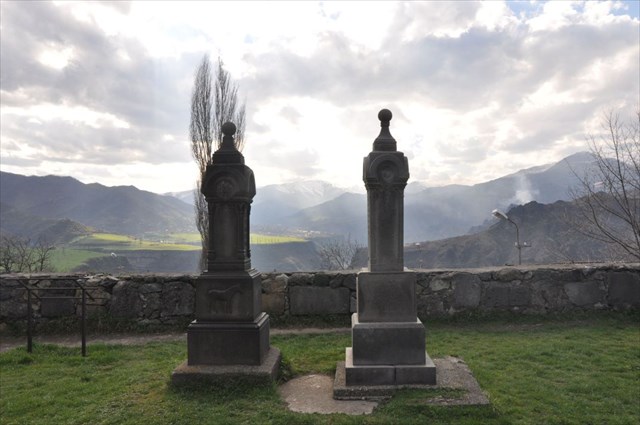
The infiltration of secular themes shows in the miniatures created by the artist Markare for the Haghpat Gospel of 1211. These miniatures are interesting not only for their artistic features, such as the intense and somewhat darkish color scheme, but also for the artists new attitude to the world. The miniature "The Entry into Jerusalem" shows a fragment of the city, a rich house and its owner. The khorans are decorated with men’s figures in secular costumes of those times. Of interest are the representations of standing men in expensive costumes, one with a jar and the other with a fish on a stick, and of a “gusan’’ musician sitting in the shade of a fruit tree.
The small churches and chapels of Haghpat and Sanahin are ordinary vaulted or domed structures differing from each other in size, details of composition and decorative features. Haghpat’s Astvatsatsin church of 1025, for instance, has quiet proportions and a low dome, while Kusanats anapat (nunnery) of the early 13th century has more dynamic proportions — the fractional bulk and a higher octahedral cupola decorated with an arcature composed of trefoil arches.
Annex are the largest structures of Sanahin and Haghpat, interesting monuments of medieval Armenian architecture. They were intended for morning and evening services. Parishioners for whom there was no room left in the temple stood there. The annex also served as sepulchers for outstanding figures and for the aristocracy. The annex (jhamatuns) were added to churches, hut there were also jhamatuns of the same type which stood separately from the church, sometimes next to it. In this case the jhamatuns did not only discharge their regular functions as annex but also served as places of meetings and councils of secular and church notables of the appropriate principality.
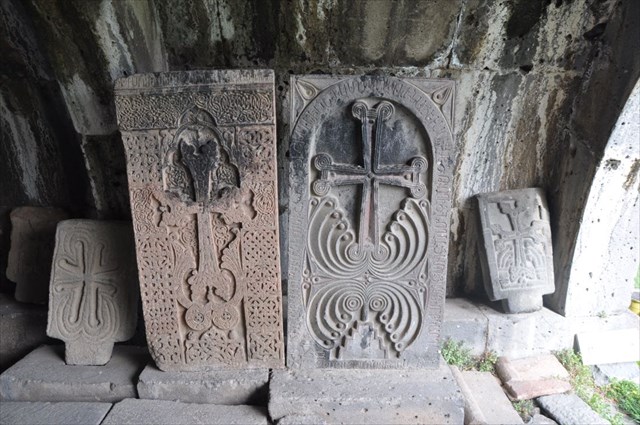
Such jhamatuns include the so-called Amazasp building in Haghpat, erected in 1257. This is the usual type of structure rectangular in the plan with four inner abutments — the biggest such structure in Armenia. Identical columns and wall abutments, as well as the vaulted roofings of perimetral sections, devoid of ornamentation, add to the expressiveness of the tori-decorated octahedron of the central part. The squat proportions of the building and its architectural details create the impression of interior and exterior heaviness. A small annex is attached to the chapel on the eastern side.
The vestry of Nshana church, the most outstanding structure of Haghpat, has an intricate spatial arrangement. Originally, it was a small vaulted gallery-type sepulcher of the Kyurikid kings, built in 1185. Under Father Superior Ovanes of Khachen. it was extended westwards in 1209 and roofed with a system of ribs composed of two pairs of crossing arches repeated twice in height. This is a unique structure with a daring system of roofings which gives the interior unusual roominess and grandeur. The artistic form of the interior is extremely expressive, which makes the vestry very much different from others. The large-span arches rest, on three sides, on wall abutments and, on the fourth, western, side, on mighty columns made as a bunch of slender shafts crowned with appropriately divided tori and ornamented abaci. The simplicity of the rest of the abutments and the almost complete lack of decoration enhance the architectural expressiveness of the entrance part of the interior. The slightly squat exterior is crowned with a horizontal cornice and a two-part pointed roof with a graceful rotunda. The stony smoothness of the western facade is decorated with window edges and a broad flat platband of the entrance. The architectural and compositional features of the vestry of Nshana church had a substantial influence on the formation of many structures of medieval Armenia. especially civil ones.
Vestries and galleries, as well as special structures, served as sepulchers for members of aristocracy. There are several such structures in Sanahin and Haghpat. They differed from each other in their architectural composition, which is evidence of the great creative ingenuity of their architects. The most ancient of them is the sepulcher of Kyurike and David Kyurikids in Sanahin which consisted of two vaulted cells, isolated from each other, one built at the end of the 10th century, and the other in the middle of the 11th century.
The sepulcher of Ukaniants family in Haghpat (the early 8th century) is made as three large rectangular memorial chapels standing side by side. These also serve as pedestals for khachkars. Such structures were simplified —chapels were replaced by pedestals cut by deep niches — as, for instance. in the tombstone with a 1268 khachkar in Ashtarak.
The bell-towers of Sanahin and Haghpat are the earliest examples of structures serving this purpose. These are tall three-floor towers with small annexes at various levels and a many-column rotund belfry on top. Sanahin’s bell-tower, built between 1211 and 1235, is of severe and laconic appearance. The bell-tower is crowned with a light rotunda, which became a characteristic feature of later separate bell-towers of Armenia. The smart western facade is singled out by a large ornamented cross of dark-red stone in a heavily shaped frame. The asymmetrically shaped windows, khachkars and carved spheres of yellow sandstone give the facade a picturesque and appealing look.
The 1245 bell-tower in Haghpat is less conventional. Its first storey is cross-shaped in the plan, and the second one rectangular, with the angles cut off. The transition between the two is formed by trompes beautifully decorated with original combinations of trefoils. Over the trompes the wall is crowned, just like the other walls of the structure, with triangular gables, which soften the transition from the lower bulk to the rotunda. The building is somewhat squat. It is decorated with picturesque architectural details — twin windows with columns, facade gables, varying in their sizes and in the height of their placement, and a septahedral belfry, the pointed roof of which is shaped like that of the main building. The artistic composition of Haghpat’s bell-tower found its reflection not only in later bell-towers such as the one in Kars, but also in various other buildings — mausoleums and even churches.
The book depositories of Haghpat and Sanahin are unique buildings illustrating the high level of development of civil architecture in 11th‑13th-century Armenia. Such buildings were erected, as a rule, away from the main churches of the monastery. They were square-shaped in plan and had a niche for keeping manuscripts in. Special attention was paid to the design of the roof which gave the book depositories a distinctive appearance.
Originally, Haghpat’s book depository, built in the middle of the 11th century, had a wooden roof, probably a round and pointed one, resting on internal pillars. The stone roof resting on crossing arches and built between 1258 and 1262, changed the artistic look of the interior substantially. Differing in their sizes and shapes, the arches carrying the overhanging wall tops and the arches of the niches do not only emphasize, by their arrangement, the central axes of the premise, but add to the impression of its considerable height.
The octahedral tent-roof with a light opening in its top, situated in the center of the ceiling, contributes to this impression. The architectural decoration, concentrated on wall-attached abutments and on the transition hand at the base of the tent-roof, depends on the latter. The severe shapes of the niches and of the half-columns and the ceiling arches, proportionate to them, impart clearness to the shape of the interior.
The refectory of Haghpat stands out among the civil monuments of Armenia. This structure, dating back to the middle of the 13th century is rare in its architectural composition. The prototypes of its roofing can be seen in the palace halls of Dvin and Haruch and in the guest rooms of the peasant home. One is impressed by the enormous space of the stretched-out hall of the refectory divided by columns in length into two parts roofed separately by two pairs of crossing arches. The central sections of the roofings are crowned with octahedral domed vaults with light opening at the tops. The graceful slightly pointed arches, spanning the width of the hall, give a light, almost weightless look to the high ceiling composed of well-proportioned braces, intersecting arches, vaults and domes, The intersecting arches, which begin much lower than the wall cornices and which seem tote extensions of the abutments, and the parts of the cylindrical vaults they support create a smooth transition from the wall to the roofings. The entrance, located in the buildings butt, determines the longitudinal-axis perception of the interior. In the character and details of decoration, the interior of the refectory is close to that of Haghpat’s book depository, which suggests that the two were created by architects of the same school.
Small structure over water springs, which are still in use, are of special interest among the monastery buildings. Their architectural composition, based on the principle of symmetry, is simple and laconic. These are vaulted premises. rectangular in the plan, with arched openings or the main, longitudinal, facade. The 1831 structure over a water spring in the yard of Sanahin monastery is a single-arched one: a village structure of this kind in Sanahin, dating back to the end of the 12th and the beginning of the 13th century, is twin-arched, and the 1258 structure in Haghpat is triple-arched, with the middle arch larger than the side ones and emphasizing the central axis of the structure. There are stone troughs stretching along the back wall of the structure for watering the village cattle, and also a water reservoir used by local residents. The vaulted composition was prompted by the climate of the country. The cool and damp air inside is a good protection against the scorching midsummer sun. The inner spaces, almost totally open in front, enrich the outer appearance of these purely utilitarian structures.
Sanahin and Haghpat complexes are especially rich in khachkars (more than 80 of them have survived), which were intended not only as memorials. Some of them were installed to mark various events: in Sanahin, one was put up on the occasion of building a bridge in 1192, another one, of building an inn in 1205, and others are Tepagir (1011), Tsiranavor (1222), etc. In Haghpat, khachkars were built to perpetuate philanthropic activities of the persons whose names are inscribed on them (Amenaprkich, 1273). Some of the khachkars are quite sizeable. and their pedestals are high and fancy-shaped.
Most of the khachkar have the traditional shape of a cross which germinated out of a grain, with branches on its sides. In the khachkars of the 10th—11th century the framing of the cross was simpler than that of the 12th—13th century khachkars which developed new stylistic features. Ornamentation, which imparts picturesqueness to the general appearance of the khachkar and which covers the whole of the slab is mainly geometrical, consisting of stylized floral motives, squares which never repeat each other in their delineation and rosettes — some in the forefront, other in the background, and still others sometimes in between. The lacy patterns and their intricate interweavings on Sanahin’s Grigor Tudevordi khachkar (1184) or Sarkis khachkar (1215) are truly amazing for the ultimate skill of their execution. As distinct from them, Amenaprkich khachkar in Haghpat (1273) stands out for a great number of realistically depicted human figures fitted into the unique composition of the decor. Sophisticated ornamental compositions and their very high artistic level put the khachkars of Sanahin and Haghpat among outstanding works of Armenian art.
The ensembles of Sanahin and Haghpat stand out not only for the original architecture of religious and especially civil buildings. They are also most instructive as samples of town building art which show high skill of Armenian architects. Marked by the unity and compactness of their asymmetrical layout, they had a tremendous influence on the development of medieval Armenian architecture.
source wikipedia